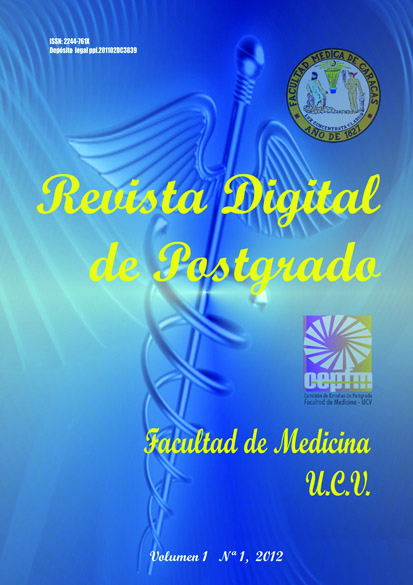CONCENTRACIÓN ESPIRADA FINAL DE SEVOFLURANE PARA RETIRO DE TUBO ENDOTRAQUEAL Y MÁSCARA LARÍNGEA SIN COMPLICACIONES EN PACIENTES PEDIÁTRICOS
Palabras clave:
Fracción espirada final, Sevoflurane, máscara laríngea, tubo orotraqueal, tos, agitación, laringoespasmo, preescolaresResumen
Para determinar fracción espirada final de sevoflurane al retirar tubo orotraqueal y máscara laríngea sin complicaciones en pacientes pediátricos, se elaboró estudio observacional de tipo descriptivo y, transversal, seleccionando un total de 40 pacientes de pediatría quirúrgica (Hospital Universitario de Caracas) para cirugías urológicas y hernioplastias, distribuidos en grupo T (tubo orotraqueal) y grupo M (máscara laríngea). Premedicados con Midazolam recibieron anestesia inhalatoria y bloqueo regional. Mantenimiento: O2/aire 50/50. Concluida la cirugía se retiró dispositivo según parámetros hemodinámicos, clínicos y ventilatorios. Hubo diferencias estadísticamente significativas entre ambos dispositivos para presión arterial sistólica y diastólica, tiempo retiro del dispositivo de la vía aérea – salida del quirófano (TR) y complicaciones, no para fracción espirada. Se concluyó que para retiro de máscara laríngea y tubo orotraqueal, la fracción espirada final de sevoflurane fue de 0,66 y 0,87 respectivamente, siendo la máscara laríngea el dispositivo más recomendado por menor TR y menor número de complicaciones.Descargas
Citas
REFERENCIAS
- Barash P, Cullen F, Stoelting R. Clinical Anesthesia, 4° ed. USA: Lippincott Williams and Wilkins; 2001.
- Lerman J, Inhalation agents in pediatric anaesthesia-an update. Curr Oping Anaesthesiol. 2007; 20: 221-226.
- Paladino M. ¿Cómo, cuándo y por qué los Anestésicos Inhalatorios en Pediatría? Farmacocinética y farmacodinamia de los anestésicos inhalatorios en pediatría. Rev Argent Anestesiol. 2004; 2(2): 28-30.
- Miller, D. A Proposed Classification and Scoring System for Supraglottic Sealing Airways. Rev Anesth Analg. 2004; 99:1539 – 53.
- Lerman J, Gregory G, Willis M, Eger E. Age and Solubility of Volatile Anesthetics in Blood. Anesthesiology. 1984; 61:139-143.
- Sarner J, Levine M, Clinical characteristics of sevoflurane in children: a comparison with halothane. Anesthesiology. 1995; 82(1):38-46.
- Somarriba F. Sevoflurane a Flujos Bajos en Anestesia General para Niños. [Trabajo Especial de Grado]. Nicaragua: Universidad de León; 2000.
- Gilsanz F. Sevoflurano en la anestesia balanceada. Interacciones farmacológicas en anestesia [Internet]. IV Congreso Ibero-Latino-Americano, XII Congreso Luso-Español y XXVI Congreso de la Sociedad Española de Anestesia, Reanimación y Terapéutica del Dolor; 2003 Junio; Barcelona. Disponible:
http://www.anestesiavirtual.com/marzo04/Simposium%20Sevorane%20Aveiro.pdf
- Inomata S, Suwa T, et al. End-Tidal Sevoflurane Concentration for Tracheal Extubation and Skin Incision in Children. Anest Analg. 1998; 87:1263-7.
- Malviya S, Lerman J. The Blood/Gas Solubilities of Sevoflurane, Isoflurane, Halothane, and Serum Constituent Concentrations in Neonates and Adults. Anesthesiology. 1990; 72:793-796.
- Lerman J, Sikich N, Kleinman S, et al. The pharmacology of sevoflurane in infants and children. Anesthesiology. 1994; 80: 814-824.
- Aouad M, Nasr V. Emergence agitation in children: an update. Curr Opin Anaesthesiol 2005; 18:614-19.
- Granados S, Circuito Abierto, Semicerrado y Cerrado. Flujos Bajos en Anestesia ¿Regresando a los Orígenes? Curso FEEA organizado por el Centro afiliado de Tijuana del 13 al 15 de Enero del 2006. México.
- Solís S, Pedrosa G, Solís S; Nuevas Alternativas de la Máscara Laríngea, AMC. 2007; 11(2):1025-55.
- Ghai B, Wig J. Comparison of different techniques of laryngeal mask placement in children. Curr Opin Anaesthesiol 2009; 22:907-52.
- Shim Y, Shin C, Chang C, et al. Optimal End-Tidal Sevoflurane concentration for the Removal of the Laryngeal Mask Airway in Anesthetized Adults. Anesth Analg 2005; 101:1034-7.
- Astuto M. Anesthesia Intensive Care and Pain in Neonates and Children. Italia: Springer-Velarg; 2009.
- Wodey E, Senhadji L, Pladys P, Carre F, Ecoffey C. The Relationship Between Expired Concentration of Sevoflurane and Sympathovagal Tone in Children. Anesth Analg. 2003; 97:377-82.
- Aantaa R, Takala R, Muittari P. Sevoflurane EC50 and EC95 values for laryngeal mask insertion and tracheal intubation in children. Br J Anaesth. 2001; 86:213-16.
- Gundappa N, Miller J. Minimum Alveolar Concentration of Isoflurane for Tracheal Extubation in Deeply Anesthetized Children. Anesthesiology. 1994; 80:811-813.
- Taguchi M, Watanabe S, Asakura N, Inomata S. End-Tidal Sevoflurane Concentrations for Laryngeal Mask Airway Insertion and for Tracheal Intubation in Children. Anesthesiology. 1994; 81:628-631.
- Lee J, Lee Y, Kim C, Kim S, Kim H. A Comparison of the End-TidalSevoflurane Concentration for Removal of the Laryngeal Mask Airway and Laryngeal Tube in Anesthetized Children. Anesth Analg. 2008; 106:1122-5.
- Kain Z, Mac Laren J, Mc Clain B, Saadat H, Wang S, Mayes L, Anderson, G. Effects of Age and Emotionality on the Effectiveness of Midazolam Administered Preoperatively to Children. Anesthesiology. 2007; 107:545-52.
- Alalami A, Markakis M, Shehata A. Pediatric laryngospasm: prevention and treatment. Curr Opin Anaesthesiol. 2009; 22:1-6.
- Udaeta E, Weiner G. Alternative Ventilation Strategies: Laryngeal Masks. Clin Perinatol. 2006; 33:99-110.
- Holm-Knudsen R, Rasmussen L. Pediatric airway management: basic aspects. Acta Anaesthesiol Scand. 2009; 53:1-9.
- Abou Hassan E, Domínguez A. Efectividad de COBRAPLA™ versus máscara laríngea (LMA™) en escolares durante anestesia general [Trabajo Especial de Grado]. Caracas: Universidad Central de Venezuela; 2004.
- Calderón E, García L y Meléndez H. Tiempos de recuperación y costos en cirugía ambulatoria, utilizando diferentes técnicas anestésicas. Rev Col Anest. 2005; 33:237-238.
Descargas
Cómo citar
Número
Sección
Licencia
Usted es libre de:
- Compartir — copiar y redistribuir el material en cualquier medio o formato
- Adaptar — remezclar, transformar y construir a partir del material
- para cualquier propósito, incluso comercialmente.
Bajo los siguientes términos:
-
Atribución — Usted debe dar crédito de manera adecuada, brindar un enlace a la licencia, e indicar si se han realizado cambios. Puede hacerlo en cualquier forma razonable, pero no de forma tal que sugiera que usted o su uso tienen el apoyo de la licenciante.
- No hay restricciones adicionales — No puede aplicar términos legales ni medidas tecnológicas que restrinjan legalmente a otras a hacer cualquier uso permitido por la licencia.












